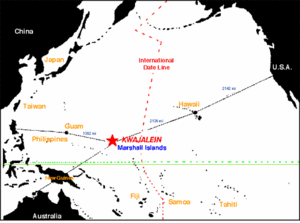Marshall Islands
Formerly a U.S. trust territory, the Marshall Islands are now an independent nation, the Republic of the Marshall Islands (RMI). Under the terms of the 1986 Compact of Free Association, the Republic of the Marshall Islands was no more under American control. The RMI was sovereign in both foreign and domestic affairs, but did grant the U.S. defense rights. [1]
According to the U.S. General Accountability Office, access to Kwajalein is the most important U.S. foreign policy interest in Micronesia.[2] Other strategic interests in the RMI and the Federated States of Micronesia (FSM) are less compelling; Western Pacific basing needs are generally met by the U.S. territory of Guam. The U.S. never responded to RMI and FSM offers for basing forces there.
Geography
They are made up of 29 atolls each made up of many islets, and 5 islands in the central Pacific Ocean between 4 degrees and 14 degrees North, and 160 degrees and 173 degrees East. They are generally in two parallel lines called the the Ratak (Sunrise) group and Ralik (Sunset) group.[3]
There are roughly 1,225 land masses, with a total of about 70 square miles, om a sea area of over 750,000 square miles. The total land area is about 70 square miles (181 square kilometers). [3] Second World WarOn 1 February 1942, the first offensive action taken by the United States Navy was a carrier air strike on Japanese facilities in the Marshall Islands, especially the Kwajalein group; Kwajalein was the main Japanese base in the region. [4] Operation Flintlock was the main campaign against the Marshalls. Bombardment began in December 1943, and the attacks began, principally against Kwajalein and surrounding islands, in January. The priorities, in 1943, Mille, Maloelap, and Wotje in the Ratak chain, and in the Ralik chain, Jaluit, Kwajalein, and Eniwetok. Jaluit was a seaplane base, all of the other Ratak sites were airfields, and the Ralik locations were anchorages for naval ships. [5] Kwajalein was taken faster than had been expected, and it was under control by February. Operation CATCHPOLE, the invasion of Eniwetok, had been scheduled for May, but the operation was accelerated to mid-February. [6] U.S. nuclear and missile testingA large number of U.S. nuclear tests were conducted in the Marshall Islands after the Second World War, requiring some short-term and some long-term relocation, and the complete destruction of some land masses. Some of the health effects of radiation were not understood at the start, as with Operation CROSSROADS,[7] although some was later known but kept classified. The power of the first thermonuclear devices, in Operation IVY of 1952, were underestimated. [8] Various damage claims have been paid, and the issue remains open. [9] Kwajalein AtollKwajalein forms the heart of the U.S. Army Reagan Missile Test Site, used in ballistic missile defense testing. The atoll extends from 8 degrees 45 minutes to 9 degrees 25 minutes North latitude, and 166 degrees 45 minutes East to 167 degrees 50 minutes East longitude. It is approximately 2500 miles southeast of Hawaii (U.S. state). Kwajalein Island is the southernmost and largest island of the atoll.
References
|

